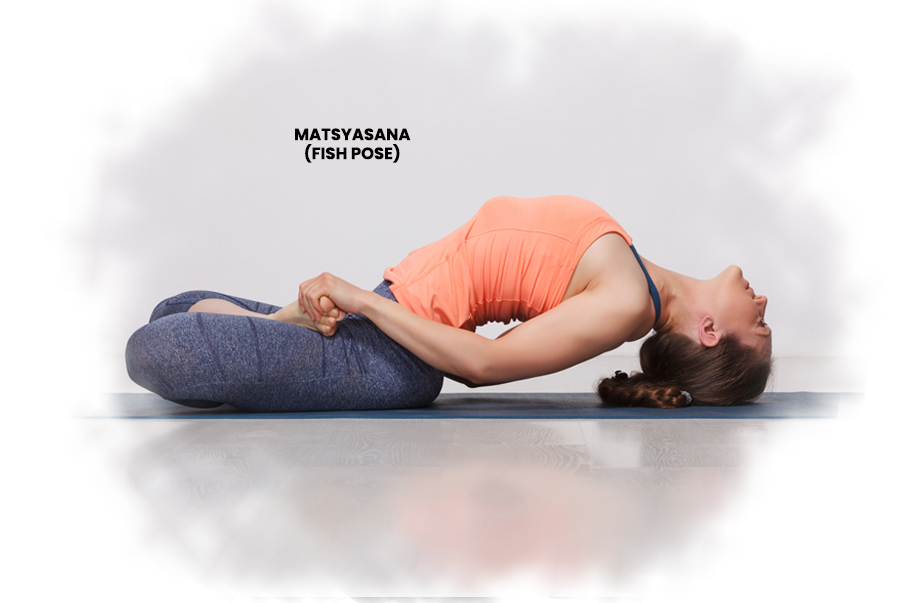Is the number of your hospital visits increasing day by day due to colds, headaches, sneezing, tenderness or fatigue? This could be Sinusitis!
As per a survey, an estimated 134 million Indians suffer from chronic sinusitis every year. However, the problem of Sinusitis can occur year-round but it is more seen in winter.
Having sinusitis is not only painful but also exhausting. In this blog, we will give you detailed information on Sinusitis (Pinas) and its relation with Yoga. You will get to know about some best Yoga asanas for sinusitis along with their benefits and a step to step guide to perform them.
Do you know what exactly Sinusitis is?
First of all, we have to understand what Sinuses are. Sinuses are the hollow spaces in our skull that keep bacteria, dust, and excess mucus away from the body. It also serves as a shield to protect our skull from any facial trauma/injury.
Thus, Sinusitis is a respiratory complaint that makes the cavities around the nasal passages inflamed. It leads to difficulty breathing, facial pain, nasal blockage/congestion, headache or runny nose. Sinusitis could arise due to bacterial infections, colds, flu, or due to other respiratory ailments.
How to know that it is Sinusitis or common cold?
Generally, people get confused about whether it is a normal cold or Sinusitis as most of the symptoms are the same. A person with a common cold gets recovered within a few days without any specific medical treatment but Sinusitis is a wide term and the cold is a symptom of Sinusitis. Chronic Sinusitis can last even for 13 weeks or longer and requires proper medical action.
In the case of Sinusitis, you may also experience headaches, reduced smelling sense, bad breathing, fever, sneezing, throat irritation, pain and tenderness around cheeks, foreheads & eyes along with a common cold.
What does Ayurveda say about Sinusitis?
Pinas is the term used for Sinusitis in Ayurveda. The main reason for the emergence of this disease falls upon the imbalanced Kapha Dosha and Vata Dosha.
Ayurveda makes use of herbs, natural oils & powders, yoga, and Nasya-karma as their Sinusitis Ayurvedic treatment. These result in ensuring permanent relief to the patient.
If you are not sure which Ayurvedic hospital provides the most effective treatment for Sinusitis? Then here it is- Dr. Sharda Ayurveda hospital. The Hospital has several branches that are located in various parts of Punjab. The online consultation facility is also available for serving mankind all over the World.
Yoga- A practice to prevent ailments
The term Yoga has been taken from ‘Yuj’- a Sanskrit word that means to join or to unite. It is a Hindu spiritual discipline for body and mind. The significance of yoga has been recognized at the international level due to its capacity to heal various disorders. It is a combination of breathing, movement, relaxation, and meditation techniques.
Does Yoga have any connection with Sinusitis?
There might be a conflicting perception in your mind about whether Yoga is beneficial for Sinusitis or not. The answer is “Yes”.
Doing Yoga helps to get rid of various ailments including sinusitis. Performing yoga asanas ease breathing by opening the air passage of the nose. The stress and tension accompanied by sinusitis are also lowered by performing some simple yoga asanas.
What are the 5 best Yoga asanas for Sinusitis?
Kapalbhati- (SKULL SHINING BREATH)
Term Kapalbhati has been made of two Sanskrit words- Kapal(Kapala) means Skull and Bhati which depicts shining. It is a Shatkarma therapy that is not only beneficial for Sinusitis but also improves brain functioning.
The Sinuses are purified by this kriya. Kapalbhati works on cleaning the inner cavity of the nose and forehead. The strenuous flow of air is generated with the motive of cleaning the sinuses and providing relief.
.jpg)
How to do Kapalbhati?
Now the question that arises is how to perform Kapalbhati. So here is a detailed step to step summary that enables you to do so:
- Step 1: Firstly, sit in a comfortable position. You can sit in Padmasana, Sukhasana or Vajrasana as per your comfort.
- Step 2: Keep your hands on your knees.
- Step 3: Make sure that your spine is straight and your neck & shoulders are relaxed.
- Step 4: Now inhale deeply. You have to breathe out with force while exhaling.
- Step 5: Now you have to pull your navel back towards but only as much as you can comfortably.
- Step 6: For 10 to 15 minutes continue this process.
Anulom Vilom Pranayama- (ALTERNATE NOSTRIL BREATHING)
Anulom Vilom is a breath exercise used in the Hatha yoga practice. It involves the movement of the nostrils for inhaling and exhaling the air. It acts as removing harmful substances while exhaling and providing strength to the body by way of inhaling fresh air.
Doing Anulom Vilom is beneficial in various ways. It improves breathing, reduces stress, empowers cardiovascular function and reduces respiratory ailments.
.jpg)
How to do Anulom Vilom?
Doing Anulom Vilom while on an empty stomach yields the maximum benefits. Following is a step to step guide for doing this asana:
- Step 1: Choose to sit in a Sukhasana/Padmasana or any other comfortable position.
- Step 2: Make your neck & spine straight and close your eyes.
- Step 3: Place the thumb of your right hand on your right nostril while keeping your ring finger toward your left nostril.
- Step 4: Inhale air through your left nostril while keeping your right nostril close with the help of your thumb.
- Step 5: Keep inhaling extensively until your lungs are full.
- Step 6: Now use your ring finger to close your left nostril and release your thumb from the right nostril.
- Step 7: Exhale slowly from your right nostril.
- Step 8: Now reverse the process and inhale with your right nostril & exhale with your left nostril.
In starting you can do Anulom Vilom for 1-2 minutes. Then slowly increase the duration for 5-10 minutes. It will surely improve Rhinosinusitis and Sinus inflammation.
Bhramari Pranayama- (BUMBLEBEE BREATH)
Bhramari has been taken from the word “Bhramara” which means Black Bee. That’s why this Pranayama is also called Humming Bee Breath. It is an ancient yoga practice calming the raging of various ailments and hypertension.
Bhramari Pranayama soothes the nervous system and ventilates the sinuses due to its anti-inflammatory results. Thus it is much more beneficial for chronic Sinusitis patients.
.jpg)
How to do Bhramari Pranayama?
You can ensure better breathing and get rid of Sinusitis by performing Bhramari Pranayama. Here is a detailed incremental process for doing Bhramari Pranayama:
- Step 1: Quietly sit in a sound & ventilated area.
- Step 2: Close your eyes.
- Step 3: Place your thumbs on your ears to close them.
- Step 4: Keep your index fingers above the eyebrows and the rest of the fingers over the eyes.
- Step 5: Make sure your mouth is closed.
- Step 6: Now inhale deeply through your nose and make a humming sound of Om while you exhale.
- Step 7: Do this again for the next 5 to 10 minutes.
To Heal chronic Sinusitis with yoga one should surely opt for Bhramari. It has no side effects and it's widely useful for removing the root causes of various respiratory disorders.
Matsyasana- (FISH POSE)
In Sanskrit, Matsya is called Fish and Asana means posture. It is a back-bending reclining asana in hatha yoga. It is very favorable for healthy lungs, digestive system, and eyes. It removes the congestion of your respiratory system because it involves expanding your chest to breathe correctly.

How to do Matsyasana?
Following is the step to step guide for doing Matsyasana.
- Step 1: Lie on your back.
- Step 2: Cross your legs in the Padmasana and relax your whole body.
- Step 3: Do not force any movement and make sure your buttocks are touching the floor.
- Step 4: Lift the chest slightly up by supporting the body with the help of your arms and elbows.
- Step 5: Take the head back and touch the crown of your head to the floor.
- Step 6: Hold your toes with your hands and keep your elbows above the floor.
- Step 7: With the support of your hands and elbows release the pose and straighten the legs.
It is important that your stomach must be empty while performing this asana. That’s why morning time is best for doing this. If you want to do this in the evening, make sure that there is a gap of approximately 4 to 5 hours between doing this asana and your meals.
Adho Mukha Svanasana- (DOWNWARD FACING DOG)
In Sanskrit, Adha means down, Svana is Dog and Asana means pose. It is a flowing sequence of Surya Namaskar. It involves stretching your whole body, especially the hands, shoulders, and back.
This is one of the best yoga asanas for sinusitis as it improves our blood circulation and opens blocked channels, thus providing immense relief from sinusitis.
.jpg)
How to do Adho Mukha Svanasana?
To do Adho Mukha Svansana one should follow these steps:
- Step 1: Firstly Stand on your feet. Bend your body downward to place your hands on the floor.
(You have to create a shape-like table where your feet and hands act as the legs of the table.) - Step 2: Slowly lift the middle portion of your body, including the hip with the help of your arms.
- Step 3: Make sure your legs & arms are straight.
- Step 4: Your heels should touch the floor and the fingers of your palm are opened. It will lead to an inverse V-shaped position.
- Step 5: Take 4 to 5 deep breaths in this still position.
- Step 6: After a while, slowly come back to the normal posture.
Doing this asana will bring blood flow to your brain and also relieves lower back pain. This asana can also be done for removing stress and anxiety.
The Takeaway
At the end of the day, we can say with confidence that Yoga is very beneficial for Sinusitis as well as stress & anxiety. Sinusitis should be given a proper medical treatment which is Sinusitis Ayurvedic treatment.
Do not neglect the minor symptoms of any ailment and make Ayurveda the pillar of your treatment.
